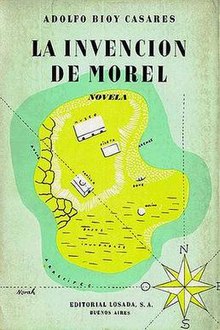The Invention of Morel

First edition dust jacket cover
|
|
| Author | Adolfo Bioy Casares |
|---|---|
| Original title | La invención de Morel |
| Translator | Ruth L. C. Simms |
| Cover artist | Norah Borges |
| Country | Argentina |
| Language | Spanish |
| Genre | Literary fiction |
| Publisher | Editorial Losada |
|
Publication date
|
1940 |
La invención de Morel (American Spanish: [la imbenˈsjon de moˈɾel]; 1940) — translated as The Invention of Morel or Morel's Invention — is a novel by Adolfo Bioy Casares. It was Bioy Casares' breakthrough effort, for which he won the 1941 First Municipal Prize for Literature of the City of Buenos Aires. He considered it the true beginning of his literary career, despite being his seventh book. The first edition cover artist was Norah Borges, sister of Bioy Casares' lifelong friend, Jorge Luis Borges.
A fugitive hides on a deserted island somewhere in Polynesia. Tourists arrive, and his fear of being discovered becomes a mixed emotion when he falls in love with one of them. He wants to tell her his feelings, but an anomalous phenomenon keeps them apart.
The fugitive starts a diary after tourists arrive on the desert island where he is hiding. Although he considers their presence a miracle, he is afraid they will turn him in to the authorities. He retreats to the swamps while they take over the museum on top of the hill where he used to live. Through his diary we learn that the fugitive is a writer from Venezuela sentenced to life in prison. He believes he is on the (fictional) island of Villings, a part of the Ellice Islands (now Tuvalu), but is not sure. All he knows is that the island is the focus of a strange disease whose symptoms are similar to radiation poisoning.
Among the tourists is a woman who sees the sunset everyday from the cliff on the west side of the island. He spies on her and while doing so falls in love. She and another man, a bearded tennis player called Morel who visits her frequently, speak French among themselves. Morel calls her Faustine. The fugitive decides to approach her, but she does not react to him. He assumes she is ignoring him, but his encounters with the other tourists have the same result. Nobody on the island notices him. He points out that the conversations between Faustine and Morel repeat every week and fears he is going crazy.
As suddenly as they appeared, the tourists vanish. The fugitive returns to the museum to investigate and finds no evidence of people being there during his absence. He attributes the experience to a hallucination caused by food poisoning, but the tourists reappear that night. They have come out of nowhere and yet they talk as if they have been there for a while. He watches them closely while still avoiding direct contact and notices more strange things. In the aquarium he encounters identical copies of the dead fish he found on his day of arrival. During a day at the pool, he sees the tourists jump to shake off the cold when the heat is unbearable. The strangest thing he notices is the presence of two suns and two moons in the sky.
...
Wikipedia
